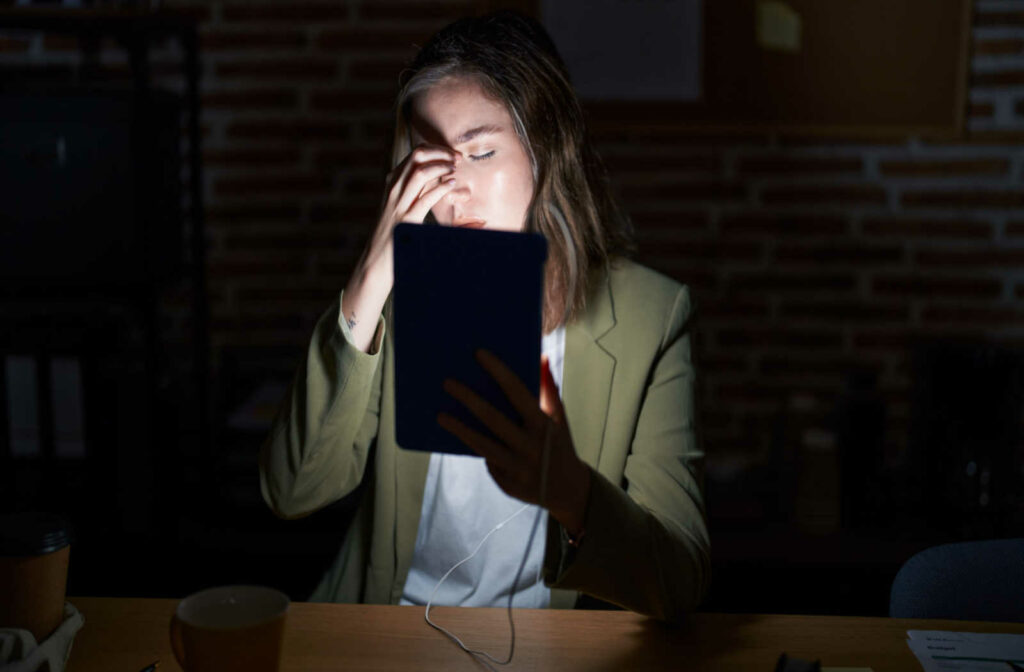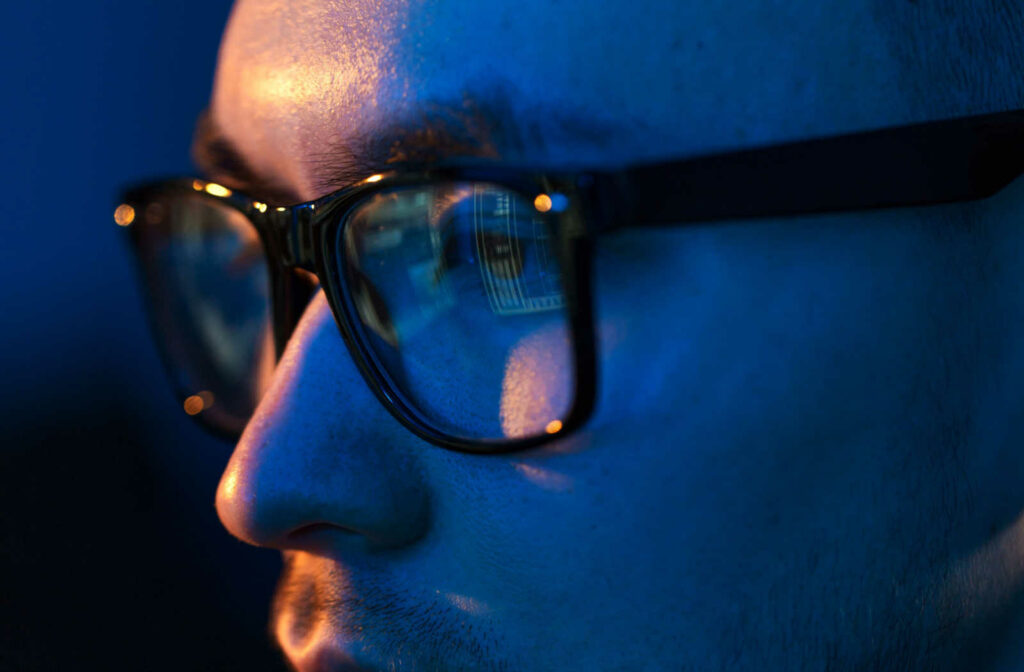How Blue Light Affects Dry Eye
Your eyes are exposed to a lot, from dry breezes to long hours staring at screens. When your eyes are overworked or overstimulated, it can impact your eye health and vision. As a result, you can experience uncomfortable symptoms like blurry vision, headaches, or dry eye.
Fortunately, you can also do a lot to protect your eyes. For example, you’ve probably heard that blue light is bad for your eyes. Blue-light-blocking treatment for lenses is often recommended to prevent digital eye strain, but can it help dry eyes?
What Is Dry Eye?
When your eyes don’t produce tears effectively or can’t successfully drain tears, you can experience dry eye. Although dry eye can affect anyone at any age, chronic dry eye is more common in older adults, as tear production has decreased.
Blinking spreads basal tears across the cornea (the eye’s surface). Although the main component of tears is water, basal tears also contain enzymes, lipids, metabolites, and electrolytes. The tear film acts as a shield, protecting your eye from debris and bacteria. It also provides nourishment and moisture.
When the tear film is missing essential components, or you produce too few tears, symptoms can include:
- Blurry vision
- Burning or scratchy eyes
- Light sensitivity
- Redness
- Stringy mucus
- Watery eyes
Over time, advanced dry eye can cause cornea damage. Severe complications of chronic dry eye include:
- Eye inflammation
- Corneal abrasions
- Corneal erosion
- Corneal scarring
- Eye infections
- Vision loss
What Is Blue Light?
The world is full is visible and invisible light, each uniquely capable of affecting our health—for better or worse. For example, you’ve likely heard ultraviolet (UV) rays can affect your health. Blue light waves sit next to UV rays on the electromagnetic spectrum, at the end of the visible light spectrum.
Blue light is not as powerful as UV light. However, blue light has the highest energy of all visible light. The sun is our primary source of blue light and ultraviolet light. Fortunately, the ozone layer absorbs some UV rays (mainly UV-B and UV-C) and scatters a significant amount of blue light. However, it’s still crucial to practice sun safety with diluted UV and blue light.
The cornea and lens (located at the front of the eye) effectively protect the retina (back of the eye) from UV damage. However, the front of the eye can’t block blue light as effectively.
The harm our eyes and skin tissue receives from artificial blue light is still being studied. Most artificial sources of blue light are weak. However, long-term exposure can increase the risk of eye problems, including digital eye strain, macular degeneration, and retina damage.

Can Blue Light Cause Dry Eye?
Unsurprisingly, blue light and dry eye tend to go together. Computers, e-readers, smartphones, TVs, and digital screens emit blue light and contribute to dry eye. Digital screens affect how we blink, interfering with our tear film.
Blue light can also affect eye health through sleep habits. Before we invented digital screens, the sun was our primary source of blue light. The sun’s blue light stimulated us to stay awake by blocking melatonin production.
Unfortunately, with digital screens, we have 24-hour access to blue light. Our screens keep us feeling alert even when it’s time to rest. As a result, our eyes can feel dry or irritated when we don’t get enough sleep.
Turn off your digital screens at least 30 minutes before bed. Some devices have night settings, limiting the amount of blue light emitted. Set up night mode for less stimulation when you need to keep working a little later or enjoy late-night screen entertainment.
Blue Light Glasses & Dry Eye
Night mode might be helpful when you’re trying to wind down for the night, but what about early mornings or the middle of the day? The settings can be uncomfortable, making your eyes work harder and contributing to eye strain. Instead of using night mode during the day, blue light glasses can help.
Blue light glasses have gained popularity with computer users because they can filter light, preventing blue light waves from reaching your eyes.
Blue-light-blocking treatment can be added to prescription lenses, so you don’t need to switch between glasses to maintain clear vision. There are also some contact lenses capable of reducing blue light.
Reducing your exposure with blue light glasses can improve comfort, allowing you to work longer or keep enjoying screen time. However, including other healthy habits is recommended to protect your eye health.
Treating Dry Eyes
Wearing your blue-light-blocking lenses limits how much blue light reaches your eye, but don’t neglect the 20-20-20 rule! Take regular screen breaks during the day and limit your bedtime exposure.
While blue light glasses can help prevent additional exposure, treated lenses can’t reverse damage. When you’re experiencing chronic or severe dry eye, talk to your eye care team about dry eye therapy. Receiving a diagnosis and treatment can help preserve your sight.
Book an appointment with Los Angeles EyeCare Optometry Group. We provide caring, personable service so you can feel confident about your eye care—from how you see to how you look. Discuss blue light glasses and dry eye solutions at your next visit!



